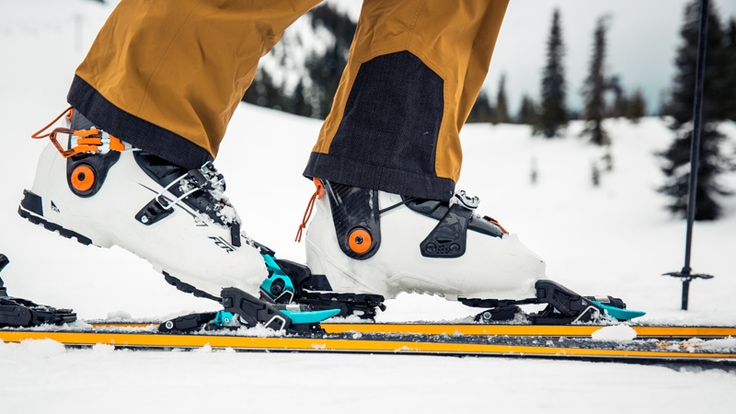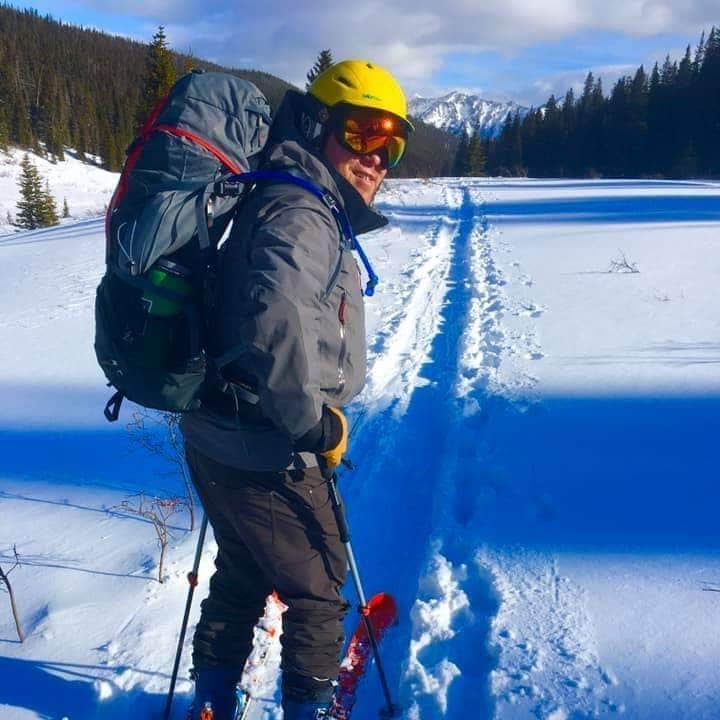Backcountry ski boots, also known as alpine touring (AT) boots, are the most important piece of equipment to consider when putting together your backcountry ski touring setup. Your boots need to fit well and be comfortable, especially if you're venturing into the winter backcountry on your own two feet.
Unlike many downhill ski boots, backcountry ski boots have two modes: one for touring and one for downhill. They have a tour/walk mode that allows a wider range of motion and a more comfortable forward stride than traditional downhill ski boots. And they also have a ski/downhill mode for those descents.
When choosing backcountry ski boots, focus on fit and performance. Here are the main things to look for:
1. Consider the type of skiing you'll do and choose a boot to fit your use:
- If you skin longer distances or do as much uphill climbing as downhill skiing, look for lighter touring-specific backcountry boots with more cuff motion, which will make touring easier and strides more efficient.
- If you are keenly focused on the descents and don't mind a bit more weight, opt for burlier, stiffer boots with optimal downhill performance.
- If you plan to ski inbounds with only occasional laps in the backcountry, consider crossover or "hybrid" boots that typically have a more traditional downhill ski boot design (such as four buckles) but come with features such as better cuff motion.
2. Find a good fit:
We recommend that you visit an REI or other boot specialist to help you find the best boot to fit your feet. Also, see our Ski Boot Sizing and Fit Guide.
3. Consider the bindings and skis you'll use:
Your boots and bindings need to be compatible. For example, tech bindings require boots with tech (pin) fittings at the toe and heel.
What Type of Skiing Will You Do?
Choosing AT boots (like choosing AT skis and bindings) often boils down to a compromise between downhill performance and uphill efficiency, though the convergence of backcountry and resort ski gear in recent years means that the gap between the two choices is closing.
Weight and range of movement of your boots are factors to consider. Also, you'll want to match your boots to the type of skis you have. For example, if you're getting burly skis because you're focused on the downhill, you'll want a heavy, powerful boot that's able to drive those skis.
Touring-Specific AT Boots
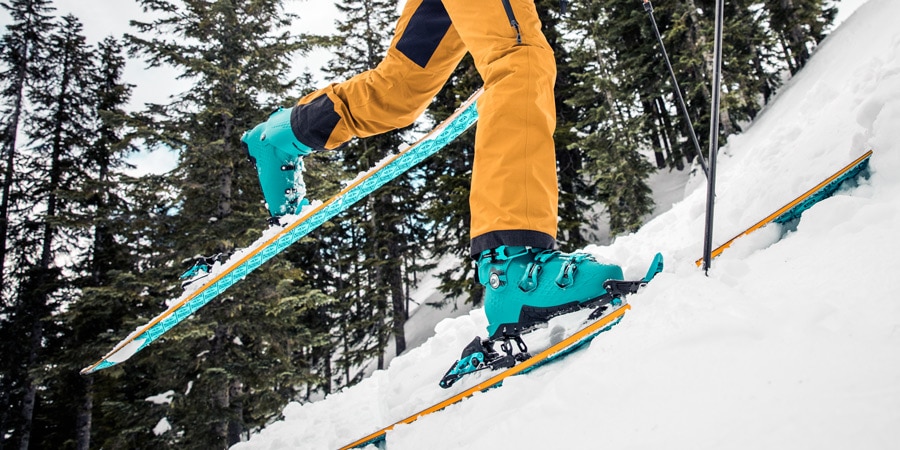
The lightest AT boots are designed for skiers who spend a lot of time backcountry touring, on multi-day tours or touring longer distances where efficiency of stride and lightness underfoot matter most. Boots in this category can range from lightweight for backcountry-only enthusiasts to ultralight for ski mountaineers or racers. The lightest boots weigh 3 pounds or less per pair, while lightweight ones can range between 3 and 6 pounds a pair.
- Lightweight boots make touring easier and uphill climbing much more efficient.
- Boots designed for touring typically have more cuff range, which means greater movement and flexibility as you tour ("skin").
- Lightness means you sacrifice some downhill performance and stiffness.
- More rockered (curved) and a grippier rubber sole make for easier walking, scrambling or boot packing.
- Boots typically have two or three buckles and tech (pin-style) fittings.
Crossover Boots
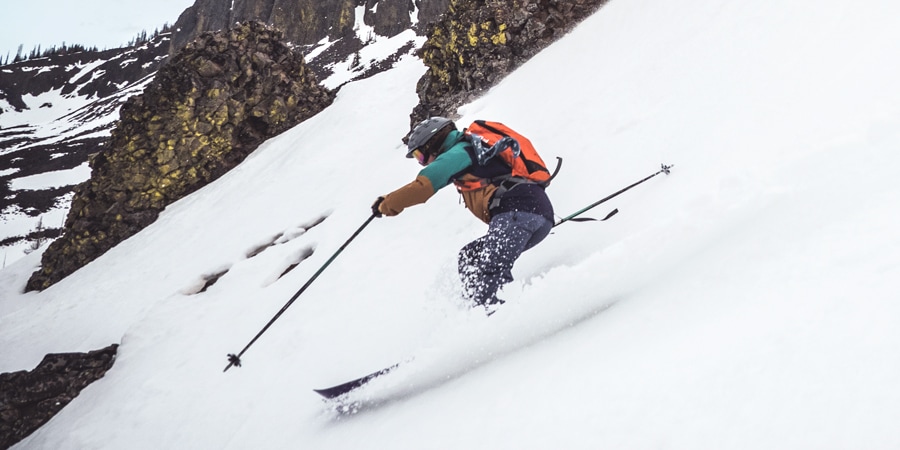
These hybrid ski boots typically have a more traditional downhill ski boot design (such as four buckles) but with features that allow you to tour in them, such as better cuff motion or tech inserts (pins) to fit tech bindings. Such crossover boots are great for skiers who spend lots of time in resorts and only occasionally venture into the backcountry or dabble with touring inbounds.
- They're typically lighter than traditional downhill ski boots but heavier than touring-specific boots.
- They excel on the downhill but may not be as efficient on the uphill as touring-specific boots.
- A heavier, more downhill-oriented boot may not have as much cuff motion.
- Many crossover boots can work with both alpine bindings and AT bindings with no or some modifications.
Find a Good Fit
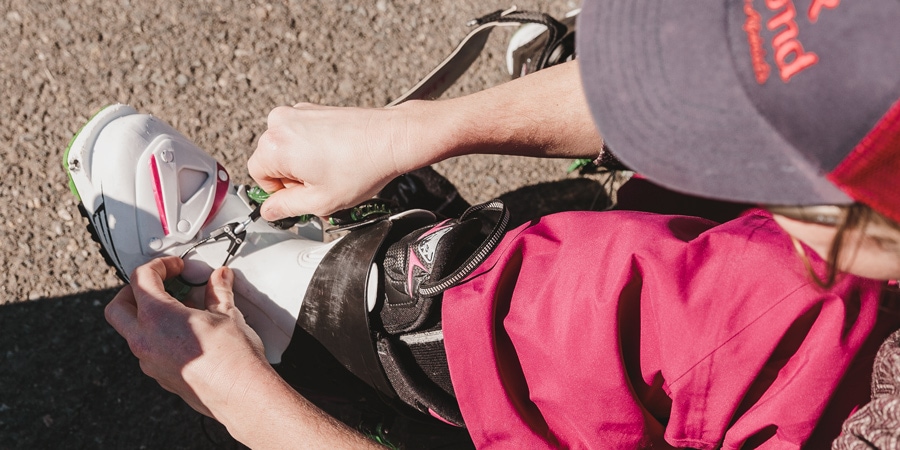
A good boot fit is key to having a good day in the backcountry. Take the time to try on several pairs of boots in person to find a comfortable fit. You can contact us by email, live chat or by phone at 1-800-426-4840. Read more in our Ski Boot Sizing and Fit Guide.
Here are some other things to know:
Mondopoint sizing: Backcountry ski boots often use an international sizing standard called mondopoint, which officially calculates the width and the longest length of your foot in millimeters. (However, many boot manufacturers commonly express mondopoint [or mondo] in centimeters so you will also see 26.5 rather than 265 mm). Sizes are not always uniform by brand or even from one model to another, so be sure to consult a particular brand's boot-sizing chart.
Measure both feet: This is where visiting a boot fitter or specialist is helpful. They'll measure your feet—the length and width—and find boots that will fit the shape of your feet.
Fit the outer shell: Ski boots have a hard outer shell for support and a soft liner for cushioning and warmth. The soft inner liner of your boot will get compressed ("pack out") over time. A good-fitting shell should have some room inside it. Remove the boot's soft liner and put your foot (while wearing your ski socks) into the shell; there should be no more than three-quarters of an inch of space behind your heels. If anything, it's OK to have a little bit more room in alpine touring boots than in downhill ski boots.
- Aim for about three-quarters of an inch for a more relaxed recreational fit (and more toe room).
- Aim for about a half inch for a greater performance fit.
How they should fit: With your liner back in your boot, your boots should feel snug. Start with snug boots because they will pack out over time. Your toes should touch the front of your boot, but when you flex, your toes should pull back.
Consider a custom insole: Adding a custom insole is a common way to improve fit and increase performance and comfort. For a little extra support, try a cut-to-fit insole. If you have known foot issues, choose a physician-made orthotic.
Flex: Ski boot manufacturers rate boots on a flex index: the higher the number, the stiffer the boots. The more rigid your boot, the more power transfers to your skis' inside edges so they excel at downhill performance. REI.com product pages list the flex index under the "specs" tab. But flex numbers can vary between manufacturers. It's best, when possible, to try on several pairs.
What Bindings Will You Use?
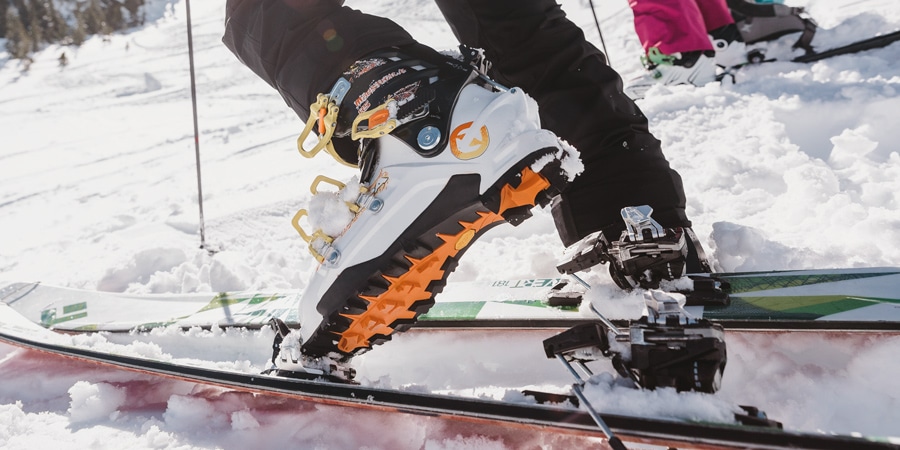
Your alpine boots and bindings need to be compatible but matching your boots to your bindings can quickly become confusing. It's best to start by finding boots that fit you before looking for bindings to match. (Read more about How to Choose Backcountry Ski Bindings). If possible, visit an REI or other boot specialist to help you sort through binding and boot compatibility. And make sure you check the manufacturer to confirm that your bindings and boots work together.
There are exceptions (and modifications you can make), but in general here is a rough guide:
- If you want to use tech bindings, you'll need tech-specific boots that have tech inserts (fittings) at the toe and heel. Many AT boots come with tech inserts.
- Most alpine touring boots are designed with a curved profile (rockered) and grippy rubber sole for easier walking and better grip. Boots certified to an international standard called ISO 9523 are compatible with most tech and AT frame style bindings.
- AT boots that are not certified to the ISO 9523 (sometimes called non-compliant) will only work with tech bindings. These tend to be fast and light racing boots.
- Most downhill ski boots are compatible with most AT frame bindings.
- Many AT boot soles will work with Multi-Norm Certified (MNC) bindings.
